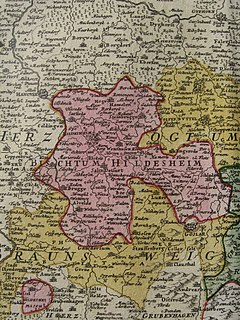Related Research Articles

The West Slavic languages are a subdivision of the Slavic language group. They include Polish, Czech, Slovak, Kashubian, Upper Sorbian and Lower Sorbian. The languages have traditionally been spoken across a mostly continuous region encompassing the Czech Republic, Slovakia, Poland, the westernmost regions of Ukraine and Belarus, and a bit of eastern Lithuania. In addition, there are several language islands such as the Sorbian areas in Lusatia in Germany, and Slovak areas in Hungary and elsewhere.

The Eighty Years' War or Dutch Revolt (c.1566/1568–1648) was an armed conflict in the Habsburg Netherlands between disparate groups of rebels and the Spanish government. The causes of the war included the Reformation, centralisation, taxation, and the rights and privileges of the nobility and cities. After the initial stages, Philip II of Spain, the sovereign of the Netherlands, deployed his armies and regained control over most of the rebel-held territories. However, widespread mutinies in the Spanish army caused a general uprising. Under the leadership of the exiled William the Silent, the Catholic- and Protestant-dominated provinces sought to establish religious peace while jointly opposing the king's regime with the Pacification of Ghent, but the general rebellion failed to sustain itself. Despite Governor of Spanish Netherlands and General for Spain, the Duke of Parma's steady military and diplomatic successes, the Union of Utrecht continued their resistance, proclaiming their independence through the 1581 Act of Abjuration, and establishing the Protestant-dominated Dutch Republic in 1588. In the Ten Years thereafter, the Republic made remarkable conquests in the north and east against a struggling Spanish Empire, and received diplomatic recognition from France and England in 1596. The Dutch colonial empire emerged, which began with Dutch attacks on Portugal's overseas territories.

The Winkler Prins is a Dutch-language encyclopedia, founded by the Dutch poet and clergyman Anthony Winkler Prins (1817–1908) and published by Elsevier. It has run through nine printed editions; the first, issued in 16 volumes from 1870 to 1882, and the last, numbering 26 volumes, from 1990 to 1993. Winkler Prins has been the most distinguished printed encyclopedia in the Dutch language. Publisher Elsevier collaborated with the Microsoft Corporation to put the 1993 version plus any new additions onto CD-ROM in 1997 as the Dutch-language version of Encarta.
The term Stift is derived from the verb stiften and originally meant 'a donation'. Such donations usually comprised earning assets, originally landed estates with serfs defraying dues or with vassal tenants of noble rank providing military services and forwarding dues collected from serfs. In modern times the earning assets could also be financial assets donated to form a fund to maintain an endowment, especially a charitable foundation. When landed estates, donated as a Stift to maintain the college of a monastery, the chapter of a collegiate church or the cathedral chapter of a diocese, formed a territory enjoying the status of an imperial state within the Holy Roman Empire then the term Stift often also denotes the territory itself. In order to specify this territorial meaning the term Stift is then composed with hoch as the compound Hochstift, denoting a prince-bishopric, or Erzstift for a prince-archbishopric.

The Prince-Bishopric of Münster was a large ecclesiastical principality in the Holy Roman Empire, located in the northern part of today's North Rhine-Westphalia and western Lower Saxony. From the sixteenth to the eighteenth centuries, it was often held in personal union with one or more of the nearby ecclesiastical principalities of Cologne, Paderborn, Osnabrück, Hildesheim, and Liège.

Cambrésis is a former pagus, county and prince-bishopric of the medieval Holy Roman Empire that was annexed to the Kingdom of France in 1679. It is now regarded as one of the "natural regions" of France, and roughly equivalent to the Arrondissement of Cambrai in department Nord. The capital of Cambrésis was Cambrai. Originally ruled by a dynasty of counts, Cambrésis became a prince-bishopric in 1007, comparable to the Prince-Bishopric of Liège and the Prince-Bishopric of Utrecht. It encompassed the territory in which the bishop of Cambrai had secular authority.

The Prince-Bishopric of Hildesheim was an ecclesiastical principality of the Holy Roman Empire from the Middle Ages until its dissolution in 1803. The Prince-Bishopric must not be confused with the Diocese of Hildesheim, which was larger and over which the prince-bishop exercised only the spiritual authority of an ordinary bishop.
Nassau-Orange-Fulda was a short-lived principality of the Holy Roman Empire from 1803 to 1806. It was created for William Frederick, the son and heir of William V, Prince of Orange, the ousted stadtholder of the abolished Dutch Republic after the Batavian Revolution of 1795.

The Utrecht war of 1481–83 was a diocesan feud in the Prince-Bishopric of Utrecht between 1481 and 1483, influenced by the ongoing Hook and Cod wars in the neighbouring County of Holland. It was also a battle for control over Utrecht between the Dukes of Burgundy in the person of ruling Bishop David of Burgundy, and the Duchy of Cleves, which sought to replace him with Engelbert of Cleves.

The Münster Diocesan Feud, or simply Münster Feud, was a dispute that took place between 1450 and 1457 over the appointment to the bishop's throne in Münster, and hence the rule of the diocese. The cause was the death of the previous prince-bishop, Henry II of Moers. The opposing candidates were his brother Walram of Moers, Eric of Hoya, and Conrad of Diepholz. They were supported by their families with Count John of Hoya, Archbishop Dietrich II of Moers and Prince-Bishop Rudolf of Diepholz at their respective heads. In addition, there were also external allies. Within the diocese the Stände, namely the cathedral chapter and the town of Münster, played an independent role at times. In the end neither candidate was able to succeed to the office.

The Oranienstein Letters are a series of letters sent by William V, Prince of Orange in December 1801 from Schloss Oranienstein near Diez, Germany. William addressed them to 15 Orangist ex-regenten of the old Dutch Republic and advised them end their staying out of government. That meant that some of his instructions given in the Kew Letters, which urged resistance against the French–Batavian invasion, were no longer in effect. He and his son, William Frederick, also recognised the Batavian Republic as legitimate and renounced their hereditary stadtholderate. Those were preconditions set by First Consul Napoleon Bonaparte of the French Republic for compensation for the loss of their possessions in the Netherlands, which had been confiscated by the Batavian Republic.

The Battle of Jutphaas, also known as the Battle of the Vaart or the Battle of Vreeswijk, occurred on 9 May 1787 on the banks of the Vaartsche Rijn canal near Jutphaas and Vreeswijk between Orangists and Patriots.

The Wars of the Loon Succession is the name of the war of succession that arose after the childless death of Louis IV, Count of Loon on 22 January 1336. In the first period, the County of Loon led by claimant Diederik of Heinsberg managed to maintain its autonomy in relation to the Prince-Bishopric of Liège. During the second period, however, Arnold of Rummen, the last indigenous claimant to the title of count of Loon, first had to sell the County of Chiny to the Duchy of Luxemburg to cover his military expenses, and soon after conceded defeat. The wars came to an end with the annexation of Loon by Liège in 1366.

The imperial church system was a governance policy by the early Holy Roman emperors and other medieval European rulers to entrust the secular governance of the state to as many celibate members of the clergy of the Catholic Church as possible instead of to the non-celibate laity. Rulers did this because celibate clergymen could not produce legitimate heirs who could claim their inheritance at death, and thus not establish regional dynasties that could threaten the power of the ruling family. Upon their deaths, the areas governed by celibate clerics automatically reverted to the ruler, who could then appoint their own new confidants to the position and thus retain control of all parts of the realm. A bishop thus bestowed with temporal (secular) power of a prince, on top of his spiritual (religious) power as a bishop, was known as a prince-bishop, and his domain as a prince-bishopric.

The Utrecht Schism was a diocesan feud in the Prince-Bishopric of Utrecht from 1423 to 1449. The legitimate prince-bishop of Utrecht was at issue. The war of succession was fought by Zweder van Culemborg and his brother Walraven van Meurs against Rudolf van Diepholt. The conflict mixed with the existing Utrecht factionalism between the Lichtenbergers and Lokhorsten and with the Hook and Cod wars raging in the County of Holland. Some scholars consider the Utrecht Schism to have ended in 1429.

The period between the start of the Beeldenstorm in August 1566 until early 1572 contained the first events of a series that would later be known as the Eighty Years' War between the Spanish Empire and disparate groups of rebels in the Habsburg Netherlands. Some of the first pitched battles and sieges between radical Calvinists and Habsburg governmental forces took place in the years 1566–1567, followed by the arrival and government takeover by Fernando Álvarez de Toledo, 3rd Duke of Alba with an army of 10,000 Spanish and Italian soldiers. Next, an ill-fated invasion by the most powerful nobleman of the Low Countries, the exiled but still-Catholic William "the Silent" of Orange, failed to inspire a general anti-government revolt. Although the war seemed over before it got underway, in the years 1569–1571, Alba's repression grew severe, and opposition against his regime mounted to new heights and became susceptible to rebellion.
Factionalism in the medieval Low Countries, in Dutch historiography known as partijstrijd or (partij)twisten, comprises several political, military and socio-economic conflicts in the Low Countries during the Middle Ages, especially the Late Middle Ages. The so-called 'parties' usually behaved like factions, which were formed ad hoc, could rapidly change in composition, and usually did not have strong ideological underpinnings. They were not officially organised political parties as would emerge in the 19th century. The parties were normally led by an aristocratic clan, followed by patrician families, and eventually several groups from the bourgeoisie, generally organised by guilds. These groups could often switch allegiances, names and goals, secede or defect, depending on how situations and interests evolved. Usually there were long-term tensions and only brief military confrontations, which either resulted in a new balance of power, or confirmed the status quo. The ruling dynasties or bishops could be dependent on the support from the strongest faction in order to govern, and in case of a war of succession, pretenders were compelled to ally themselves with one party or the other to stand a chance as seizing power. Foreign powers could interfere in factionalist struggles by providing financial or military support, and sometimes take over control of a province with the help of a local party.
References
- 1 2 3 Wilhelm Kohl. Die Bistümer der Kirchenprovinz Köln. Das Bistum Münster 7,1: Die Diözese. Berlin, 1999. Germania Sacra , New Series, Vol. 37,1; ISBN 978-3-11-016470-1 ( , p. 170, at Google Books), pp. 170–184.
- ↑ Istvan Bejczý, Een kennismaking met de middeleeuwse wereld (2004) 76–77, 199. Bussum: Uitgeverij Coutinho.
- 1 2 Encarta-encyclopedie Winkler Prins (1993–2002) s.v. "bisschop §5.1 Investituurstrijd". Microsoft Corporation/Het Spectrum.
- ↑ Encarta-encyclopedie Winkler Prins (1993–2002) s.v. "Investituurstrijd". Microsoft Corporation/Het Spectrum.
- ↑ Printy, Michael (2006). Enlightenment and the Creation of German Catholicism. Cambridge: Cambridge University Press. pp. 83–84. ISBN 9780521478397 . Retrieved 18 January 2020.
- ↑ Welz, Reinhard (2006). Alte europäische Städte. Mannheim: Reinhard Welz Vermittler Verlag e.K. p. 415. ISBN 9783866563667 . Retrieved 22 January 2020.